 September 23, 2007
September 23, 2007

What does the sea have in store for divers in Singapore?
Swing by the Urban Forest blog to get a glimpse of some of the creatures you can expect when exploring the depths of Singapore waters!
Photo: Angie/Urban Forest blog
 Posted in Uncategorized
Posted in Uncategorized  No Comments »
No Comments »
 September 19, 2007
September 19, 2007

Excerpt from ICCS Blog: The turtle named Puteri Pulau Upeh was ‘first spotted on 29 July 2006 as she laid 108 eggs in an unusually shallow pit which she dug, on Pulau Upeh. The remains of what appeared to be a fishing net was stuck in a crack on the back of her shell.The fishing net and some barnacles were removed and she was tagged. It was assumed that she was a young nester.’
“A satellite transmitter was attached onto her shell on 29 August 2006, after her third nesting for the season. She was released at 2.20am the same night…â€
‘She began her journey southwards on 14 September 2006 and crossed over to Singapore waters approximately two weeks later. Since February 2007, she has stayed in the southern islands of Singapore and must be feeding amongst coral reefs that still exist today.’
Visit the WWF Malaysia Satellite Tracking of Hawksbill Turtles page to find out more.
 Posted in Uncategorized
Posted in Uncategorized  1 Comment »
1 Comment »
 September 17, 2007
September 17, 2007
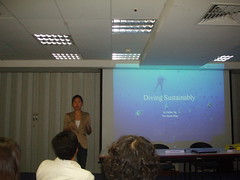
Last week, the NUS Student Affairs Department invited The Hantu Blog to give a talk about dive conservation to amateur or budding divers.


The two hour workshop also included presentations by dive doctor Dr. Gregory Chan, and Singapore Underwater Federation President Stephen Beng.

I managed a half hour presentation that discussed the various ways a diver interacts with the natural underwater environment and how a diver can adapt an awareness and behaviour that minimises the impact of diving on the ocean environment.
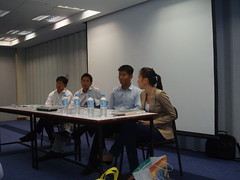
Also discussed were how non-diving behaviour can also have a consequence on the environment such as littering on the coast. Of particular interest was the topic of consumer responsibilities such as choosing an environmentally-responsible diver operator, dive resort or liveaboard.

As a consumer, you have the responsibility to pay for services that are sustainable. Things to be aware of when planning your dive trip should include: Has the dive operator showed commitment towards sustainable diving practices? Does the dive resort discharge effluent fresh water into the nearby coast? Does the liveaboard have a septic tank and proper waste disposal management?
Your conscientiousness can help make diving a more sustainable activity, and your awareness from even before you learn to dive, could help make you a better diver. For example: Have you streamlined your gear so it doesn’t get snagged in coral? Are you proficient in buoyancy control so that you are able to avoid crashing and ‘walking’ on coral? Have you taken a skill refresher course if you haven’t dived in more than a year? How well do you know about the marine life around you so you don’t do anything that my disrupt their natural/wild behaviour?
If you’d like to organise a talk for your school or office, email us!
 Posted in Uncategorized
Posted in Uncategorized  No Comments »
No Comments »
 August 28, 2007
August 28, 2007
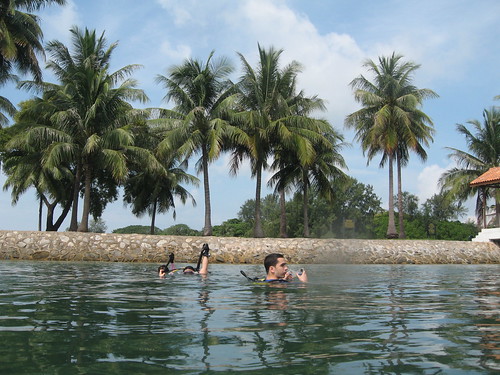
We had comparatively better weather than we had on last months Blog Dive. Despite there being rains throughout the week, the sunshine held up except for a very light drizzle after the first dive. Because of the improved visibility (3-5m) I spent most of my time shooting the colonies of coral which on other days might not be so easy to shoot from afar.



With this Blog entry, I’m trying out a new style of posting. More of what we saw over the weekend throughout our three years is now available in our new Gallery! This Gallery is powered by Flickr and designed by One Diver. Above (L-R): Seawhip, Seafan (Gorgonian coral), and a tiny Seafan recruit





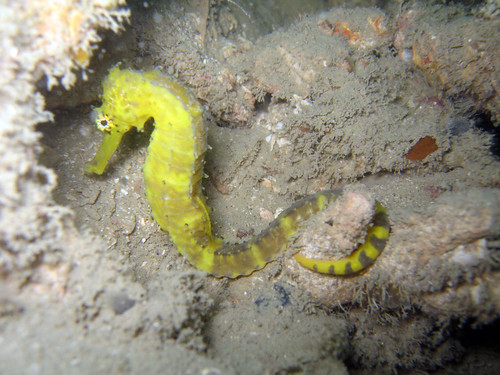
Lots of pretty fishes this weekend, from this (from left) Long-finned Batfish, to Harlequin sweetlips, Five-lined cardinalfish, Tomatoclown anemonefish, seagrass Filefish, and of course, a Tigertail seahorse!










But most of all, we managed to have some great views of the huge coral colonies that continue to thrive on Hantu’s reef. Usually the reduced visibility means that the large colonies can be hard to photograph.




There were also alot of tube worms! All of those were saw today were growing within large coral colonies…
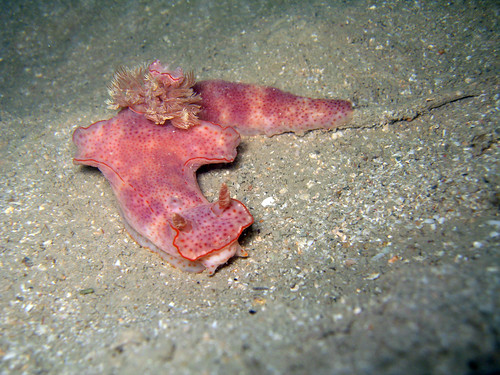
And of course! Everybody’s favourite… Sea slugs! Today was the first time I managed to find a Ceratosoma nudibranch without enlisting someone else’s help! Thanks to Chay Hoon for teaching me how to look out for them. Whilst I got so excited at spotting one nudibranch, Chay Hoon spotted 3! Despite the hundreds of dives at Hantu, I’ve got lots more to learn, and still tons more to see!
Swing by our Gallery to see more photos from this weekend’s dive!
 Posted in Uncategorized
Posted in Uncategorized  No Comments »
No Comments »
 August 28, 2007
August 28, 2007
Last Sunday’s Blog Dive went swell! Some of your might’ve already seen photos from that dive uploaded by regular Blog diver and Blogger herself, Chay Hoon. The Hantu Blog will be testing out a new method of photo-sharing on the Blog so the photos are going to take awhile to be loaded up. Please bear with us!
Meanwhile, I shot a handful of cool videos on Sunday that you can get on with first!
Just before we were going to jump into the water, we spotted 2 juvenile batfishes playing just below the surface of the water. But after we jumped in and swam around to where they were, we couldn’t find them. We did find this Long-finned batfish in the deeper depths however, and shy one too! This was the only video I managed to get of it despite running into about 3 times on the reef!
I’ve alwayts felt mesmerised by watching the tentacles of Goniopora waving along the reef. Now you can get a feel of it too without the hassle of diving! The reefs of Pulau Hantu has some gorgeous “fields” of Goniopora colonies!
While taking a dive in the shallow, diver Chon Min spotted this adorable juvenile Harlequin Sweetlips. During this phase of its life, it’s much easier to shoot a video of this fish than a photograph, because as you can see, it just can’t stay still! The younger they are, the more “flippy” they tend to be.
On the last dive, also in the reef shallows we ran into about 2 families of Tomatoclown anemonefish living in HUGE and gorgeous carpet anemones. While you only see about 2 fish in this little clip, the rest of the anemone has about 8 other fishes hiding in various corners of the coral, running into the tentacles to hide whenever the camera got near!I’ll be uploading the photographs soon! So please come by again during the week to check us out!
 Posted in Uncategorized
Posted in Uncategorized  No Comments »
No Comments »
 August 10, 2007
August 10, 2007
hi all,
We have just got our new gallery up, please click here to our gallery area.
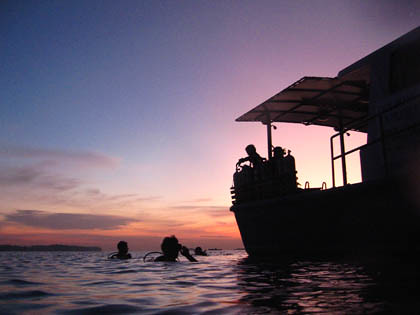
 Posted in Uncategorized
Posted in Uncategorized  1 Comment »
1 Comment »
 August 8, 2007
August 8, 2007
Hi,
Thank you for visiting pulauhantu.org (HantuBlog), we are currently working on the migration to this new server.
Please visit our current active blog http://habitatnews.nus.edu.sg/news/pulauhantu/ for new posts.
 Posted in Uncategorized
Posted in Uncategorized  1 Comment »
1 Comment »
 August 5, 2007
August 5, 2007
Research mission uncovers many new species in S’pore waters
By Shobana Kesava Straits Times 4 Aug 07
SOME gaze into the marine firmament to look for starfish. For Dr Daphne Fautin, sea anemones give her the thrills.
As she peers down a microscope, Dr Fautin, 61, exclaims with excitement: Yet another discovery has been made here in Singapore.
The sea anemone expert has not seen anything quite like it: an anemone with bumps all the way down its throat. Just hours earlier, she and a handful of local naturalists had found one with strawberry spots running down its base.
There are about 1,000 known species of anemone, the smallest and largest of which are found in Singapore.
The tiniest one known to science, just a millimetre across, was uncovered on blades of seagrass here.
The largest, over a metre in height and diameter, makes up a complete ecosystem, supporting clownfish and shrimp.
Dr Fautin’s discoveries bring the total number of sea anemone species identified here to 40.
The discoveries are potentially significant because of the dual nature of sea anemones.
Dr Fautin said they produce the most complex cell secretions. Stinging cells called nematocysts lie on these carnivores’ tentacles, paralysing prey and pulling the trapped creature towards their mouths.
‘Past studies have found this secretion fights cancer in mice,’ Dr Fautin said. New finds could lead to new drug developments.
At the same time, these animals are so simple in structure that developmental biologists can use them to understand how cells divide to become heads, limbs or tails.
While no species of anemone is believed to be endangered, Dr Fautin said that it is possible for some to disappear before they can be identified.
The hantuensis species, once spotted on Pulau Hantu, has eluded the researchers in these last few weeks despite their efforts.
Dr Fautin warns against thinking that the world won’t miss what it never knew it had.
‘Fishermen have seen crabs and fish go missing. Only later, we found out it was because the mangroves, the habitat of their young, had been destroyed.
‘Right now, we don’t know what part of the ecosystem will also be affected down the road, because anemones have been removed too,’ Dr Fautin said.
More photos of sea anemones of Singapore’s shores on wildsingapore flickr
 Posted in Uncategorized
Posted in Uncategorized  No Comments »
No Comments »
 July 31, 2007
July 31, 2007
The cold and wet weather throughout the week made me a bit nervous about going for a dive. The last we hope for is having to cancel a dive because of bad and dangerous weather. But we should be so lucky, as moderate to good weather held up on Sunday, and thank goodness! Because Keppel Marina is undergoing renovations through to next year, we departed from Pasir Panjang Ferry Terminal.
 Though we saw generally fewer nudibranches than were were used to on the reef, there were some super finds that made the trip all worth our while. Silver moonies and schools of damsels played the top of the reef slope, and in the deep I encountered my first Ceratosoma Trilobatum Nudibranch. Thanks to Chay Hoon for spotting it for me! Thanks also to her for taking all the lovely pictures featured in this Blog Log as I so cleverly brought my camera less the memory card this trip!
Though we saw generally fewer nudibranches than were were used to on the reef, there were some super finds that made the trip all worth our while. Silver moonies and schools of damsels played the top of the reef slope, and in the deep I encountered my first Ceratosoma Trilobatum Nudibranch. Thanks to Chay Hoon for spotting it for me! Thanks also to her for taking all the lovely pictures featured in this Blog Log as I so cleverly brought my camera less the memory card this trip!
 We did manage to spot some Blue Dragon nudibranches such as the one above, which was really tiny! Other tiny creatures that we manage to spot were cuttlefish! Chay Hoon and I spotted 3 altogether, and in 3 different sizes too! One was the size of your pinky nail, the 2nd the size of date, and the last one was about the size of a clenched fist.
We did manage to spot some Blue Dragon nudibranches such as the one above, which was really tiny! Other tiny creatures that we manage to spot were cuttlefish! Chay Hoon and I spotted 3 altogether, and in 3 different sizes too! One was the size of your pinky nail, the 2nd the size of date, and the last one was about the size of a clenched fist.
 Another beautiful nudibranch we ran into was this Chromodoris Lineolata. Chay Hoon and her amazing memory, blurted the its Latin name the moment we surfaced from the dive! I was flabberghasted. These critters feed on sponges and are found throughout the tropical Indo-West Pacific, growing up to 30cm!
Another beautiful nudibranch we ran into was this Chromodoris Lineolata. Chay Hoon and her amazing memory, blurted the its Latin name the moment we surfaced from the dive! I was flabberghasted. These critters feed on sponges and are found throughout the tropical Indo-West Pacific, growing up to 30cm!
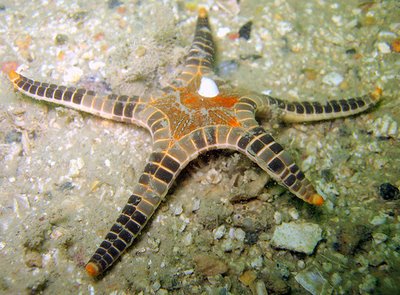 Take a closer look at this photo of the Icon Seastar, and you’ll notice quite unusual. There’s a tiny mollusc called Thyca crystallina right in the middle, on top of the seastar. It’s a parasitic sea snail that lives and feeds usually on the underside of seastars, most commonly found in shallow reef-top locations.
Take a closer look at this photo of the Icon Seastar, and you’ll notice quite unusual. There’s a tiny mollusc called Thyca crystallina right in the middle, on top of the seastar. It’s a parasitic sea snail that lives and feeds usually on the underside of seastars, most commonly found in shallow reef-top locations.
 Zoanthids are commonly sought after in the aquarium trade. In an aquarium, zoanthids are a demanding species of coral and require great effort to maintain. On the reef, zoanthids are sought after as prey by Hawksbill turtles.
Zoanthids are commonly sought after in the aquarium trade. In an aquarium, zoanthids are a demanding species of coral and require great effort to maintain. On the reef, zoanthids are sought after as prey by Hawksbill turtles.
 Acoel Flatworms are often mistaken for nudibranches. Some species of acoel tend to be small predators of copepods, other small flatworms. They are not parasitic, but can reportedly damage corals by shading. Similar to corals, some species of acoel incorporate zooxanthellae in their bodies. Given enough food and enough light, they multiplies asexually. Normally, however, the worms disappear on their own accord after a few months, presumably after having exhausted some necessary nutrient. Mandarin fish purportedly feed on acoel flatworms.
Acoel Flatworms are often mistaken for nudibranches. Some species of acoel tend to be small predators of copepods, other small flatworms. They are not parasitic, but can reportedly damage corals by shading. Similar to corals, some species of acoel incorporate zooxanthellae in their bodies. Given enough food and enough light, they multiplies asexually. Normally, however, the worms disappear on their own accord after a few months, presumably after having exhausted some necessary nutrient. Mandarin fish purportedly feed on acoel flatworms.
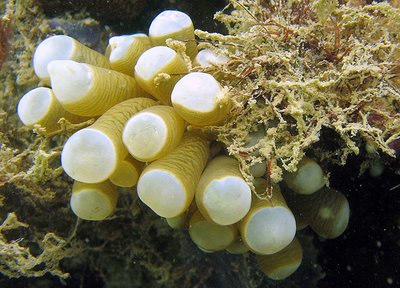 A mushroom coral recruit amongst the algae, with its tentacles outreached.
A mushroom coral recruit amongst the algae, with its tentacles outreached.
 A juvenile Harlequin Sweetlips frolicks amongst Goniopora coral.
A juvenile Harlequin Sweetlips frolicks amongst Goniopora coral.
 Found worldwide in tropical and sup-tropical seas, primarily in sandy or muddy bottoms, tube anemones are another species that are highly sought after in the aquarium trade. Tube anemones are characteristically slender smooth cones topped with two sets of dissimilar tentacles. The outer fringing tentacles are particularly well armed with stinging cells. The shorter (less than two inch) inner labial or oral tentacles assist in food gathering and manipulation.
Found worldwide in tropical and sup-tropical seas, primarily in sandy or muddy bottoms, tube anemones are another species that are highly sought after in the aquarium trade. Tube anemones are characteristically slender smooth cones topped with two sets of dissimilar tentacles. The outer fringing tentacles are particularly well armed with stinging cells. The shorter (less than two inch) inner labial or oral tentacles assist in food gathering and manipulation.
 A large marine flatworm, and possibly one of the most commonly encountered species on our reefs. Pseudobiceros sp.
A large marine flatworm, and possibly one of the most commonly encountered species on our reefs. Pseudobiceros sp.
 Tomato clown anemonefish are usually found together with bubbletip anemones, as I was told by Chay Hoon. These fish feed on zooplankton and algage amongst other things. They have also been observed to take care of the anemone they are living in by feeding it! As they say: There ain’t so such thing as a free lunch!
Tomato clown anemonefish are usually found together with bubbletip anemones, as I was told by Chay Hoon. These fish feed on zooplankton and algage amongst other things. They have also been observed to take care of the anemone they are living in by feeding it! As they say: There ain’t so such thing as a free lunch!
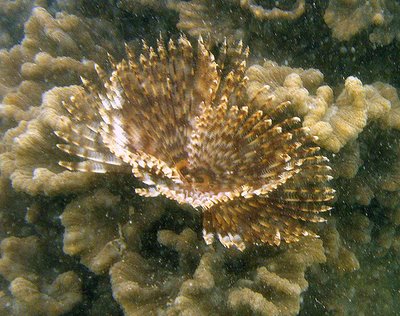 A tube worm with its feeding tentacles outstretched. That summed up the end of our day. Other critters we saw but didn’t manage to photograph include: juvenile Tiera batfish, Six-banded angelfish, Emperor
A tube worm with its feeding tentacles outstretched. That summed up the end of our day. Other critters we saw but didn’t manage to photograph include: juvenile Tiera batfish, Six-banded angelfish, Emperor
grouper, Eight-banded butterflyfish, Long-beaked butterflyfish, Paradise whiptail, Dotted Sweetlips.
For more photos of Hantu’s marine life, and a host of other beautiful living creatures in Singapore’s shores and waters, check out Chay Hoon’s Flickr site and be BLOWN AWAY!
 Posted in Uncategorized
Posted in Uncategorized  No Comments »
No Comments »
 July 21, 2007
July 21, 2007

A research team comprising Dr. Daphne Fautin from the Natural History Museum of Kansas University, Dr. Tan Swee Hee of the RMBR, NUS undergrads and nature enthusiasts made a trip to Hantu on Friday morning with the sole purpose of discovering the many species of anemones that thrive along the islands reefs.
Learn which anemones are special to Singapore and why Pulau Hantu is such an important spot for studying them at the ever exciting Budak Blog!
 Posted in Uncategorized
Posted in Uncategorized  No Comments »
No Comments »
 September 23, 2007
September 23, 2007 
 Posted in
Posted in 


















































 content rss
content rss
COMMENTS